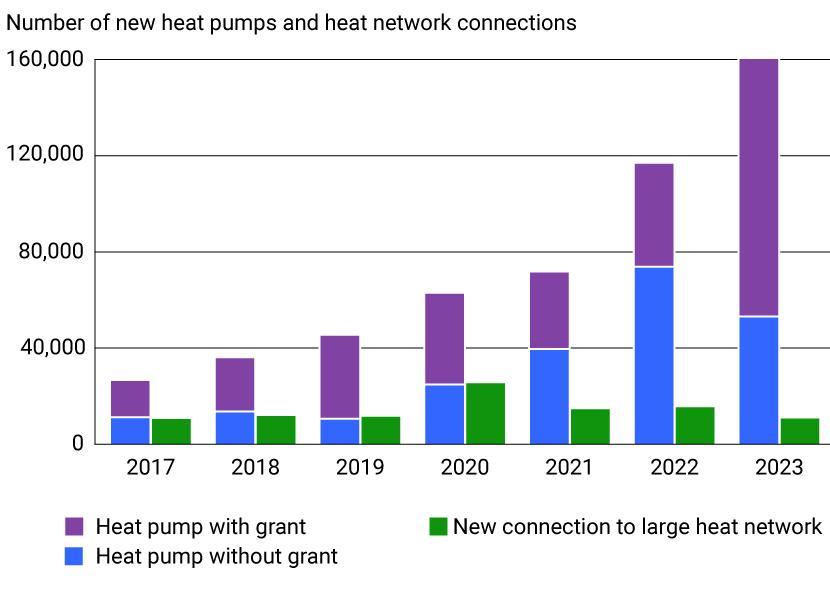Government heat network policy at odds with domestic heat pump grants
Construction of new heat networks faltering in residential districts
The number of people in the Netherlands installing a heat pump in order to cut their natural gas consumption has grown far faster in the past 7 years than the number of homes connecting to a district heating network. Government grants are available for both options so that the Netherlands will become gas-free by 2050. The popularity of heat pumps might be reducing the financial viability of new heat networks in districts with mixed building types.
The Netherlands Court of Audit concludes that the Minister for Climate Policy and Green Growth is running the risk that government grants will be used inefficiently where the 2 measures overlap. This is already occurring in parts of Deventer, Gorinchem, Groningen and Heeg. The minister does not know the extent of the nationwide overlap. Investigation by the Court found that more than 90% of grant-funded heat pumps had been installed in districts without a heat network. The overlap might be small but the Court recommends that the minister suspend grant payments for domestic heat pumps if they hold back the construction of heat networks. The findings are presented in an audit report published on 4 February 2025, A cold shower for heat networks – Time to adjust the heat transition. In 2023, 160,000 owner-occupiers opted for a heat pump to make their homes more energy efficient, in comparison with 11,000 new connections to heat networks. Domestic heat pumps tend to last 15 years.
More heat pump installations than heat network connections every year since 2017

Little growth in number of heat networks
A district heat network is the most appropriate and lowest-cost solution for a third of the built environment if the Netherlands is to become gas-free by 2050. The Netherlands Environmental Assessment Agency came to the same conclusion in the past. Heat networks are fed by residual industrial heat, geothermal heat and, for instance, biomass heat. A heat network lasts much longer than a heat pump. There are currently nearly 500, mainly small, heat networks in the Netherlands, with 515,000 connections in total. Many, mainly urban, municipalities are planning to expand their heat networks or build new ones. But several projects have run into financial difficulties since the end of 2023. Government proposals for new networks and the subsequent parliamentary debates will determine whether the impasse will be broken.
The Court of Audit has gathered data on every district in the Netherlands. 46% of homes in De Zuidlanden district of Leeuwarden, for instance, are connected to a heat network and 20% have installed a grant-funded heat pump (other homes have a central heating boiler or other heat source). In the Witbrant district of Tilburg, 85% of the homes are connected to the district heat network and 10% have their own heat pumps. Many residential districts do not have a heat network and are not planning to construct one.
Low growth in number of connections to heat networks
The number of new connections to large heat networks increased by 11,000 in 2023. The government’s aim of 500,000 new connections by 2030 therefore seems overambitious. The government has provided budgets for several grant schemes, worth at least €1.1 billion in 2024, to support the heat transition. The Court of Audit recommends that the minister consider non-grant funding to offset the front-end construction costs of heat networks.
| Both owner-occupiers and housing associations can connect to a heat network. In the case of housing associations, at least 700% of the tenants must agree. The housing association in Gorinchem noted that becoming gas-free was often distressing for residents: for elderly residents who were used to cooking on natural gas, the switch to induction was intimidating. The housing association therefore provided new pans and lessons in how to cook on an induction hob. It took a different approach for each apartment complex and held kitchen table talks with all residents. Information had to be provided on the various solutions required for different types of insulation, façades, windows and collective or individual central heating boilers. Tenants also had to change their habits because heat networks deliver heat at a lower temperature. |
High fixed costs of heat networks
Owner-occupiers and tenants are not always keen to connect to a heat network. District heating operators are monopolists; it is not possible to switch from one operator to another. Construction of a network also takes many years and the fixed costs can be prohibitive. In the Court of Audit’s opinion, the Consumer and Market Authority (ACM) did not offer consumers adequate protection before 2024 from unfair increases in the operators’ charges. Until recently, the ACM had an insight into only the return earned by the heating sector as a whole. As from this year, it has been able to correct charges if a particular heat supplier earns more than a reasonable return. It is open to question, however, whether an assessment of the rate of return is sufficient.
Evaluate funding, build support
The Court of Audit welcomed the response of the Minister for Climate Policy and Green Growth and the Minister of Housing and Spatial Planning to the report’s conclusion that alternative funding forms should be sought for the faltering heat transition. But they did not accept all the conclusions and recommendations. For example, they still need to consider whether an assessment of the rate of return on heat networks, as proposed by the ACM, will be sufficient. To build support, people must be confident that the transition to and cost of heat sources other than natural gas are justified. The Court of Audit agrees with the Netherlands Scientific Council for Government Policy that heat must remain affordable.